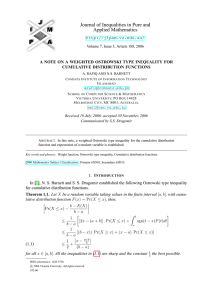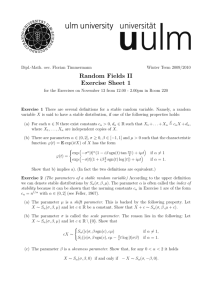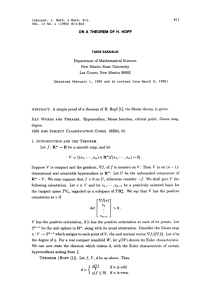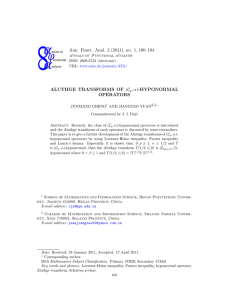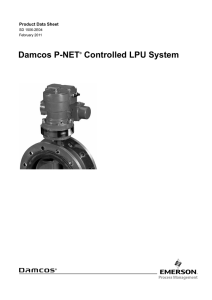Document 10944006
advertisement
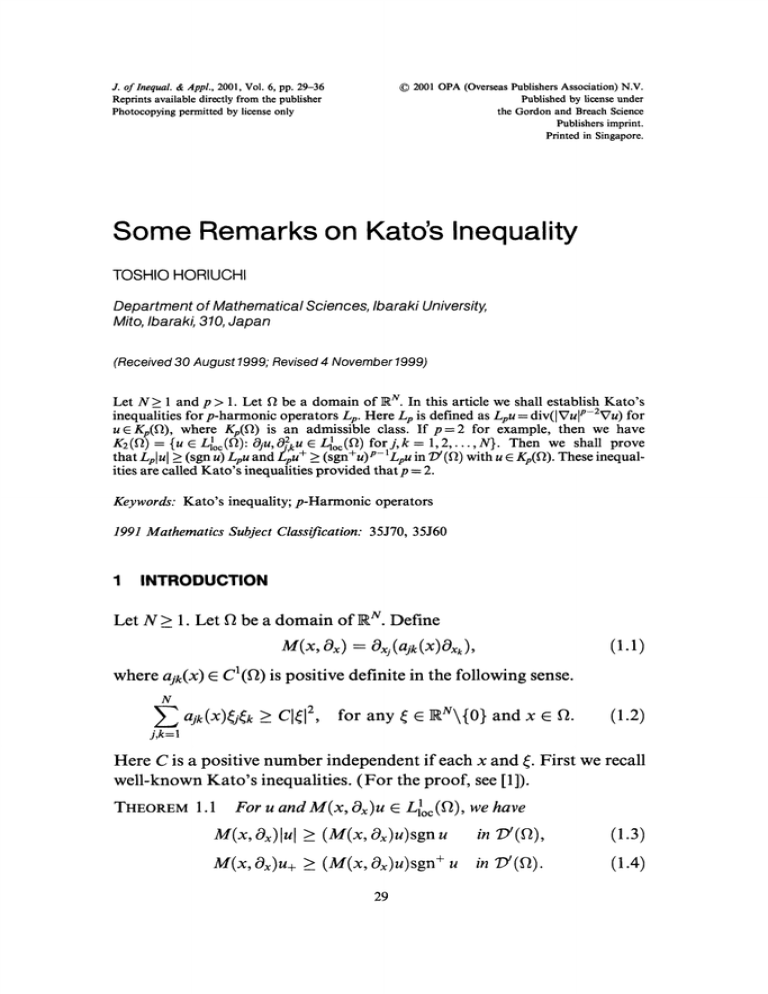
(C) 2001 OPA (Overseas Publishers Association) N.V.
Published by license under
the Gordon and Breach Science
Publishers imprint.
Printed in Singapore.
J. ofInequal. & Appl., 2001, Vol. 6, pp. 29-36
Reprints available directly from the publisher
Photocopying permitted by license only
Some Remarks on Kato’s Inequality
TOSHIO HORIUCHI
Department of Mathematical Sciences, Ibaraki University,
Mito, Ibaraki, 310, Japan
(Received 30 August 1999; Revised 4 November 1999)
Let N > and p > 1. Let [2 be a domain of N. In this article we shall establish Kato’s
inequalities for p-harmonic operators Lp. Here Lp is defined as Lpu div(lVulP-2Vu) for
u E Kp(f), where Kp(f) is an admissible class. If p= 2 for example, then we have
N}. Then we shall prove
K2(f) {u E Loc(f): Oju, O2i,k u+ /oc(9t) forj, k 1,2
> (sgn+u)’-lLeu in D’ ([2) with u Kp(f). These inequalthat Zlul >_ (sgn u) Zu and
ities are called Kato’s inequalities provided that p 2.
u
Keywords: Kato’s inequality; p-Harmonic operators
1991 Mathematics Subject
1
Classification: 35J70, 35J60
INTRODUCTION
Let N > 1. Let f be a domain of N. Define
M(x, Ox)
(1.1)
Oxj(ajk(X)Oxk),
where ajk(X) E Cl(f) is positive definite in the following sense.
N
Z ajg(x)jg > C}] 2,
for any
E
.
v\{0} and x
j,k=l
f.
(1.2)
Here C is a positive number independent if each x and First we recall
well-known Kato’s inequalities. (For the proof, see [1]).
THEOREM 1.1 For u and M(x, Ox)U
Loc(f ), we have
M(x, Ox)lul >_ (M(x, Ox)u)sgnu
M(x, Ox)u+ >_ (M(x, Ox)u)sgn + u
29
7Y(f’t),
in D’(f).
in
(1.3)
(1.4)
T. HORIUCHI
30
Here
u()
sgn u(x)=
sgn + u(x)
u O,
lu(x)l’ fo #
O,
for u=O,
1/2,
O,
and u+
foru>O,
for u O,
foru<O,
(1.5)
max [u(x), 0]. By 7Y (f) we denote the set ofall distributions on f.
In this paper we shall consider the operators defined by
Zpu- div(IVulP-2Vu),
N
IVulp-2ZXu / (p- 2)lVulP -4
OUOkuO!kU,
(1.6)
j,k=l
wherep > andOju Ou/Oxj, Oj2,k u 02u/(OXjOXk) forj, k 1,2,... ,N.
Then we shall generalize Theorem 1.1 for the operators Lp in place of
linear elliptic operators represented by the Laplacian.
This paper is organized in the following way. In Section 2 we prepare
basic inequalities including thep-harmonic operators Lp. In Section 3 we
shall state our main result, and the proof is also given there.
2
PRELIMINARY
We shall establish some fundamental inequalities for smooth functions u,
which are useful to prove our main result.
LEMMA 2.1 Assume that u E C2(9t). Then it holds that
Zlul (sgnu)Lpu
Lt, u+ >_ (sgn+u)p-lLpu
in
(f),
in
79’ (f).
(2.1)
Here by D’ (f) we denote the set of all distributions on f.
Proof For any e > 0 we set
Ue-
(U2 + g2) 1/2.
(2.2)
SOME REMARKS ON KATO’S INEQUALITY
31
Then we see
u
Oju
ue
(2.3)
Oju,
u= u+u
Ue
Here
au
02u/OV,j
p-2
>_
(O, ul
1,1e
>_-O?u.
Ue
(2.4)
1, 2,..., N. Using these we have
u
(2.5)
--Ll, U.
Ue
In a similar way we have
(/u,)_l(
,/
2
_>
tpu + (p- 1)
u-(_u) Ivulp)
Z.u.
(2.6)
Since 2u+ u + lul holds, letting e --+ 0 we have the desired inequalities.
In the next we shall consider the operators Lp,, for r/> 0 defined by
Zp,ou
div((r/2 + IVul2)(p-2)/Zvu).
(2.7)
Then we see
t,.u.
u
_(,2u
u
/
IVu12)(’-2)/2
7
(
+
Au / (p
I)
(uououo,
2)\/
-77
IVul
Ue
(2.8)
32
T. HORIUCHI
-
Similarly we can compute Lp,n((u + u)/2) to obtain the following:
Lp dT U 2
( uf)
w(+ wlVul2)
(p-)/2
(
N
Ej,k=
20),kuOjuOku)
Au + (p- 2)w
)
2VU[2)(p-2)/2( +
+ (Vw. Vu)( + wl
(p- 2)Wff
[VU[2
: + wlVul
(2.9)
Here
we--
l+
(2.10)
w_,
Therefore we have
LEMMA 2.2 For U Cc C 2(-) it holds that
(2.11)
(2.12)
Letting e
-
0, we have for u E C 2(Q)
LEMMA 2.3 For U
C2(’2) it holds that in D’(f)
Zp,.lul > (sgn u)(r/2 + IVul2)
(sgnu)Lpmu,
(p-2>12
/Xu + (p
N
j,k=_i
.uOku,u.
2)
,: + IVul:
(2.13)
SOME REMARKS ON KATO’S INEQUALITY
33
Lp,oU+ > (sgn+u)(r/2 + (sgn+u)2lVul:) (p-2)/9
N
x
3
Au + (p
u
2)(sgn+u)2- ;g----2j
(2.14)
MAIN RESULT
We introduce an admissible class Kp([2) for the operators Lp.
DEFINITION 3.1 Let p > and p*= max(p- 1, 1). Let us set
IVulp-21u] Zlo(2
forj, k
1,2,...,N}.
(3.1)
Now we are in a position to state our main result.
THEOREM 3.1 Let p > 1. Assume that u E Kp(Ft), then it holds that in
Lplul >_ (sgn u)Lpu,
(3.2)
Lpu+ > (sgn + u)p- 1Zpu.
Remark 1 (1) Ifp 2, then K2 (f) { u
for j, k 1,2,..., N }. Since L2 A in this case, it is known that Kato’s
inequalities hold under the assumptions that u, Au Loc(f ). But if
p 2, the operator Lp is nonlinear. Hence it was needed to introduce the
class Kp. Ifp > 2, we see IVulp-21Ofjul Zoc(2) by a Young’s inequality.
(2) We can also establish the same type results for the operators with
variable coefficients.
v.
Proof
Without loss of generality, we assume that Ft=ll If
u E C2(Nv), then the assertions follow from Lemma 2.1. Hence we
approximate a locally integrable function u by smooth functions up
(p > 0) as follows" Let us set B= {x E .N;
< r}. Let qa C(]1.N)
satisfy
_> 0, feu(x)dx=
IX
and q)=0 in
B.
Now We set
T. HORIUCHI
34
qOp(X)-- p-Nqo(x/p) for p > 0 and define
up(x)
p(x)
u
=_
fv
u(x y)p,( y) dy.
(3.3)
Then it is clear from the assumptions on u that as p --, 0
-
u almost everywhere
up
Up, OjUp,
Of,kUp
U, OjU,
j2.,kU
(3.4)
N
respectively.
Llop*c (N)
in
Moreover we shall show that as p ---, 0
Lpu,
Lpu
in
Loc(IRN).
(3.5)
First it follows from the definition of the operator Lp that for a smooth
function v
N
ILpvl
(p-
1)[Vvlp-2
j=l
Ikvl.
(3.6)
Lo
Therefore we see Lpu E
(N).
Nowwe assume thatp > 2. Then from H61der’s inequality it holds that
for any p > 0 and any compact set K
N
j=l
< (p 1)
j,k
IVu,lp-ldx
1’
X
(fKl,j,kUp[P-ldx)
1
< C(K)< +o.
(3.7)
Here C(K) is a positive number independent of each p > 0. Hence by (3.4)
and the dominated convergence theorem we have Lpu, Lpu in c (IRN)
Lo
SOME REMARKS ON KATO’S INEQUALITY
35
as p 0. From Lemma 1.1 and the dominated convergence theorem
we see
(3.8)
Since Lp(ur,)
Lpu in the sense of the distribution, we get
in
79’(Is).
(3.10)
Then by letting e ---. 0, we see Lpu Lplul in the sense of the distribution,
and the right-hand side tends to (sgn u)Lpu in e (/v). Therefore we get
the desired inequality.
We proceed to the case that < p < 2. In this case we make use of Lp,,
instead. First we see for any compact set K of Iv and any r/> 0,
Lo
N
j,k=l
(3.11)
ku Lo
Here we note that < p < 2 and
1, 2,..., N. Let
E
c ([N) forj, k
up be defined by (3.3). Then it follows from Lemma 2.2 that (up) satisfies
36
As p
T. HORIUCHI
-
O, we see Lp,n(up) Lp,,(u) in the sense of distribution, and the
terms in the right-hand side also converges in e (IRn). Therefore we get
Lo
in D’ (N)
(3.13)
Letting e + 0 we have in a similar way in D’ (]1N)
tp,olul
(sgnu)(v 2 + IVul2) (p-2)/2
x
(Au+(p-2)
g.uO uO ,u
\
(3.14)
Finally by letting r/ O, we have in the sense of distribution Lp,,[u[
Lp[u[, and the right-hand side also converges in c (N). After all we get
Lo
Lplul >_ (sgnu)Lpu in
(3.15)
In a similar way we can show
Lpu+ >_ (sgn + u)P-ILpu in D’(N),
(3.16)
by making use of Lemma 2.2. Therefore the assertions are proved.
Reference
[1] T. Kato, Schr6dinger operators with singular potentials, Israel J. Math., 13 (1972),
135-148.




